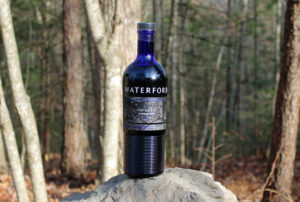Waterford Peated Fenniscourt Irish Single Malt Review
By Richard Thomas
Rating: B

(Credit: Richard Thomas)
To a large extent, Waterford Irish Whiskey represents an entrepreneur taking his past experience in Scotland and carrying it over into a new venture in Ireland. Mark Reynier bought a shuttered Islay distillery, Bruichladdich, in 2000, and in so doing he confronted a problem that was novel at the time. The distillery had only been closed for six years, but wasn’t exactly chugging away in terms of production before that, so any brand built upon it was inevitably going to confront a hollow period when it didn’t have enough whisky in stock for making the entry and middle run levels of a conventional line-up.
Stop and think about it. Just a few years after getting started, Reynier and his master distiller, Jim McEwan, would already start hitting the wall in terms of being able to create even an eight year old single malt. Considering that 18 year old Scotch is still generally considered merely middle-aged, it would be two decades of waiting before this gap would cease to matter to what most single malt lines consider their bread and butter expressions.
The company dealt with this problem by choosing a grain-driven approach, choosing to borrow from the wine industry’s terroir concept by emphasizing more flavorful barley choices than the standard distiller’s grain, chosen more for its alcohol potential than its other attributes. This malt-forward style actually works better at younger ages, cutting short the influence of the cask as it does.
Reynier and his investors sold Bruichladdich to Remy Cointreau in 2012, and Reynier began looking for a new venture. He found a recently closed Guinness brewery in Waterford, Ireland, and in 2015 jumped into the Irish Whiskey business. Drawing on past experience, the new Waterford brand would root itself in young, grain-forward whiskeys.
Waterford Peated: Fenniscourt is made from Arcadian barley, grown at Fenniscourt in County Carlow. It’s peated to a middling level, 38 ppm, using sphagnum-heavy peat from County Kildaire. Another aspect of releasing a younger whisky like this one is that peat influence is one of the things that tends to fade over decades-long aging periods, so it sings more than one would think in a youthful release of this kind. A third factor pushing the flavors the single malt has at this stage is its strength: it’s bottled at 50% ABV, a level familiar to the many fans of the American bottled in bond whiskeys.
The Whiskey
The pour has the color of straw, and a nose that smacks of smoldering, dry compost. It’s a peaty essence that has no sea spray to it at all, but is more like burning vegetation that got dredged out of a tannic moorland watercourse, dried, and then thrown on the fire. This rests heavily atop a base of honey tinged with ginger.
On the palate, the flavor isn’t light, but it is lively enough that I found myself thinking I had a highball without the soda carbonation. It’s got some spring in its step, far more than one would expect from a 50% ABV whisky. The peat is a strong presence, taking on a more herbal character now that it is on the palate, while the malty honey base adopts some Constant Comment tea style seasoning. The peat runs into the finish, turning earthy and ashy.
A flavorful, but not particularly complicated dram, I urge all peatheads to try it for two reasons. First, any real fan of peat should be eager to become better acquainted with the flavors of regional peats. Second, said fans should also be keen on the notion of younger whiskeys retaining more of those peat flavors.
The Price
Officially, Waterford’s Peated Fenniscourt Single Malt is priced at €94, approximately $103 at the time of writing.




